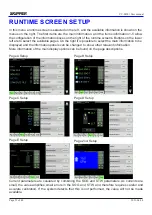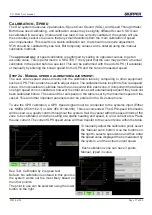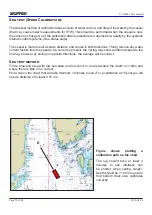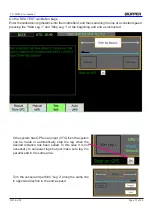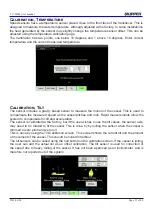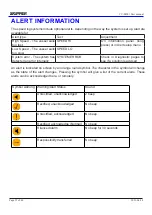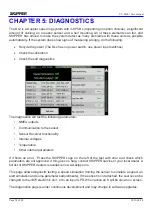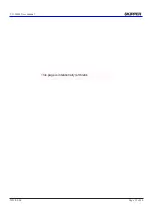
2021-06-24
Page 35 of 40
CU-M001 User manual
Available options in the diagnostic page
Simulators
Speed
In this page it is possible to set a fixed speed and to send this to the sensor. This will result in the
speed being presented on all displays and outputs. This mode is a full simulator and will verify that
all electronics and processing in the system are operational. When active an orange ‘S’ will show on
screen.
Alert
By pressing the alert simulator a typical alert will become active. this can be acknowledged as
normal, and will disapear when the simulator is removed.
If the received data does not seem to be correct, it is possible to tune the system . The system has
3 operational modes
1. Shallow water <3m, The system adjusts the sampling length to the minimum available. at some
stage the bottom factor may interfere.
2. Deeper water >3-40m, The system will adjust the sample length for bottom and water to maximalise
the accuracy
3 Very deep water>80m The bottom track (SOG) switches to a long distance mode. In this mode the
system may be susceptable to noise if there is rapid acceleration of the vessel. (small vessels are
most susceptable)
If the system is cutting out occasionally, this could be related to acoustic interference. with a usb
stick inserted, the system can be made to logg a deeper raw data to the stick. these files can be sent
to skipper for analysis, or viewed using the tools in the skipper service software. set the raw data
type to the parameter with problems and press start. The system will present the GPS data while
this function is in use to prevent interference with navigation. This data should be collected when the
vessel is experiencing the issue.
if the system has problems stopping this function, a restart of the electronic unit may be required.
In coastal areas it is not uncommon to find a layer of warmer fresher water on top of a lower colder
water. These layers can slide across each other in different directions and if the sensor samples
across this layer its result will be wrong. For this reason the default is to measure as close to the
vessel as possible to avoid this situation.
Currents in this lower area is often less than at the surface, if the STW reading is moved further from
the vessel then the current value will reflect that area, not the area influencing the vessel.
Logging data: If you require external help to solve a problem Data can be logged and sent to
service@skipper.no. Placing a USB stick in the JB70 unit will start the logging. You can also use the
free SKIPPER service software available at www.skipper.no to log via the network port.
In this case, connect a PC via LAN. start the communications button, and log on the UDP terminal.
To get the most out of this data, turn on the DIAG sentence in the communications setup for UDPM
on the display. The files generated, both in LAN logging and USB, log the data currently being sent
on the UDPM output. It is therefore important to turn on the DIAG output on the UDPM channel to
ensure the sensor and relevant input data is also logged.


